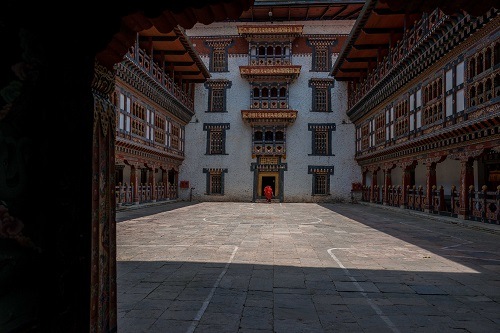Trashigang Dzong ‘The Fortress of the Auspicious Hill’ is one of the largest ancient fortresses in Bhutan. It is strategically located on the ledge of a mountain with steep cliffs on the three sides, overlooking the confluence of the Drangme Chhu and the Gamri Chhu. The fortress in eastern Bhutan was built in 1659 to defend against Tibetan invasions. Presently the dzong is used as the seat for the district monastic body and administration of Trashigang district. The present dzong was enlarged by Dzongpon Dopola in 1936.

According to legend, it is said that upon seeing the Trashigang Dzong, the invading Tibetan armies remarked that the dzong was “a Sky Dzong and not on the ground” as they retreated. It has been the political stronghold of eastern Bhutan for over 300 years.
The dzong was consecrated and named as Trashigang by Dudjom Jigdral Yeshe Dorje. After the 1962 Sino-Indian War, Bhutan allowed Indian soldiers returning home to pass through eastern Bhutan. However they were required to deposit their rifles at the armoury in the dzong, and proceed through Bhutan unarmed. The rifles lie in the dzong to this day.
Trashigang Dzong is only accessible from the north, via a narrow road, paved by blasting through the cliff-side. At the entry gate, on the left, there is a fine mani lhakhang and a slate carving of Seng Doma, a local protector who is half-male, half-female.
Trashigang Dzong suffered severe damage after the earthquake in 2009. The epicenter of the earthquake is only 16km (ten miles) away from Trashigang Dzong. Several restorations have been executed to preserve its original structure. Extensive renovations to the dzong were completed in 2019.

Inside Trashigang Dzong, there are six lhakhangs (temples). The 1st-floor goenkhang features paintings of a yeti, while another chapel is dedicated to the deity Choegi (Yama) Gyelpo, the wrathful aspect of Chenresig. He is a protector of the faith, the god of death and the king of law, who weighs up the good and evil at the end of a person's life.
Many lama dances are performed in Trashigang to appease Yama. The annual popular three-day Trashigang Tshechu is held at Trashigang Dzong in November or December.